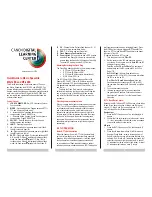
Falcon 4M Camera Manual
DALSA 03-032-20044-01
37
Determining the Y parameter
As mentioned, the Y parameter is around 500 us. The Y parameter depends upon the
number of rows used, whether the camera outputs at 80 MHz or 65 MHz, and whether
the camera being used is in 2 tap mode (Falcon 4M30) or 4 tap mode (Falcon 4M60). To
obtain the Y parameter, execute the
gcp
command. The camera should respond and
state:
“Frame Dump Time: 487.5 us”.
The 487.5 us used here represents the Y parameter for the factory settings of the Falcon
4M60.
What do I do if I cannot use either Snapshot Mode?
DALSA recommends that the camera is operated using a Snapshot Mode. However, in
some cases this may not be possible. Therefore, the camera can be setup to disable
Snapshot Mode (
efd 0
) and return the camera to the mode used prior to the
introduction of Snapshot Mode.
Different snapshot modes will produce different FPN and possibly different PRNU
patterns. The user is encouraged to match the snapshot mode with their corresponding
coefficients. This camera has 16 sets of coefficients, 8 factory and 8 user:
CSN
EFD
0, 3, 8, 11
1
1, 4, 9, 12
0
2, 5, 10, 13
2
6, 14
All coefficients = 0
7, 15
FPN/PRNU Test Pattern
FPN and PRNU coefficients for set 0 (
csn 0
) were calculated with EFD 1 and set 1 with
EFD 0 as shown above, etc. Set 6 has all coefficients set to 0/1 (FPN / PRNU) and set 7
has coefficients calculated from test patterns SVM 7 and 8. Sets 8 to 15 are user-writable
sets which mirror their factory counterparts as shown above.
Example:
•
The user changes from snapshot mode 1 to 0.
•
In order to load the appropriate coefficients we must first point to the right set by
sending
csn 1
.
•
The coefficients need to be then loaded into volatile memory by sending
lpc
.
•
If the user wishes to load
csn 1
on camera power-up then these settings should be
saved by sending
wus
.
















































